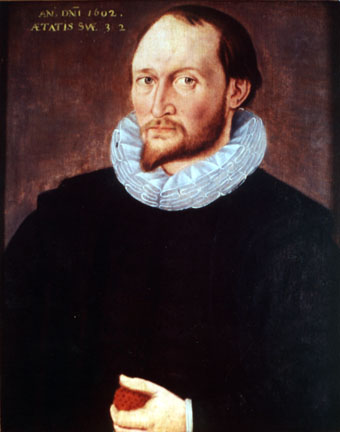
Caption: "Portrait believed to be of Thomas Harriot (c.1560--1621) (also spelt "Harriott" or "Hariot"), an English astronomer, mathematician, translater, ethnographer, explorer, and Renaissance man apparently painted during his lifetime.'' (Somewhat edited.)
Features:
- Harriot would be
a much more famous person than he
is if he'd bothered to publish some of his important
discoveries
and innovations.
In fact, he would rank with
Galileo (1564--1642)
and Johannes Kepler (1571--1630)---though
a bit below---as one of leaders of
Scientific Revolution (c.1543--c.1687).
But he did NOT publish, and so he is mostly just an interesting
specimen in the history of science.
- An important example
of Harriot's
unpublished works is his
Moon maps.
He drew these
starting from 1609
Jul26
(see Wikipedia:
Thomas Harriot: Later years) some months
before
Galileo.
But Galileo published promptly
in the Sidereus Nuncius (1610,
in English The Star Messenger), and so got all the credit---which is just since
what good is a discovery
that no one knows about.
The Moon maps of
Galileo
and Harriot's
are comparably good scientifically, but
Galileo was
a better artist.
- Harriot's
Moon maps show
craters,
crater rim
shadows,
the lunar maria
and
the Leaping Moon Rabbit
(see Thomas Harriot
Galaxy Picture Library: 01628 521338;
The Galileo Project:
Thomas Harriot's Moon Drawings).
Galileo's Moon maps show all these things too, of course (see The Galileo Project: The Moon; file galileo_moon_map.html).
- Another important example of Harriot's unpublished works is his discovery of Snell's law (AKA the law of refraction) which he discovered in 1602 long before Willebrord Snellius (1580--1626) in 1621.
Actually, Ibn Sahl (c.940--c.1000) discovered Snell's law much earlier and reported it in his manuscript On Burning Mirrors and Lenses (984)---but this was largely unknown until modern history of science research---maybe only in 1990 (see Wikipedia: Snell's law: History).
Another actually is that the effective discovery of Snell's law was by Rene Descartes (1596--1650) in 1637. It is an effective discovery because he published it, and so people knew of it. Snellius got credit by good luck.
- Another important example of Harriot's unpublished works is his discovery of Snell's law (AKA the law of refraction) which he discovered in 1602 long before Willebrord Snellius (1580--1626) in 1621.
Image link: Wikipedia: File:ThomasHarriot.jpg.
Local file: local link: thomas_harriot.html.
File: Astronomer file: thomas_harriot.html.